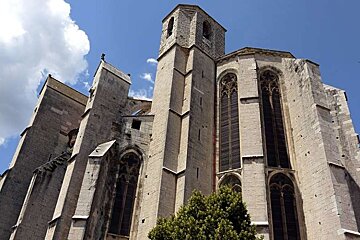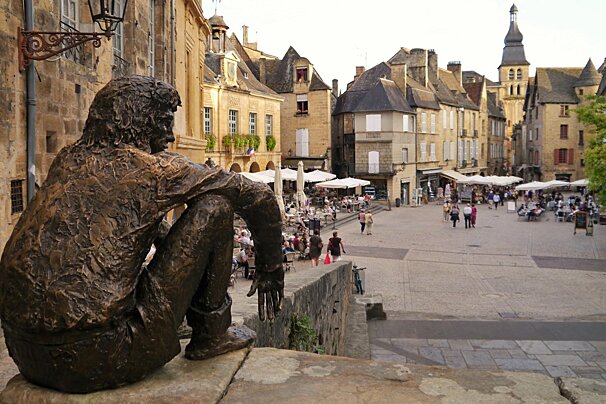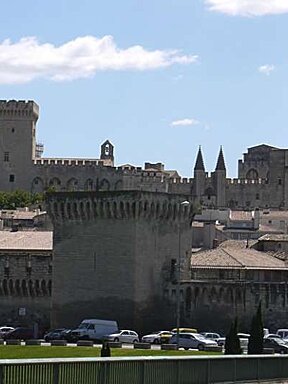
© SeeProvence.com/
Mary Magdalene and the Basilica of St Maximin
The tale of how Mary came to rest in Provence
Let’s descend into the small crypt of the Basilica in St. Maximin. To your left and to your right you see four marble sarcophagi, dating from the 4th century. They are believed to contain the remains of Mary Magdalene and four other saints, including St. Maximin.
In the rear of the crypt you'll discern a golden statue with a darkish mask. Coming closer you discover that the mask is in fact a skull, its eye sockets staring at you in defiance or reprimand - this is the cranium of Mary Magdalene.
Suspend your disbelief for just a moment, and follow the legend of Mary Magdalene in Provence. We’ll start with her departure from the shores of Palestine and end in the crypt of the Basilica in Saint-Maximin.
First a brief history of Mary Magdalene’s pre-Provençal life.
The Gospels have little information on her. We read that she followed Jesus, had seven demons exorcised from her, was present at the Crucifixion, and was the first person to see Jesus after his Resurrection. Christian tradition weaves a further tale - she was a woman of loose morals, to say the least, who repented after she encountered Jesus, then led a life of faithfulness and purity.
In the same tradition, Magdalene’s legend expands. Persecuted by the Jews of Jerusalem, she and a group of other disciples are cast off in a boat without sails or oars. In this group we also find Mary, mother of the Apostles John and James, Mary of Clopas who was also present at the Crucifixion, and John, Maximinus, Lazarus and Sarah, an Egyptian servant. Miraculously they survive the perilous voyage and safely land on the shores of southern Provence, in what is now known as the Camargue.
Soon afterwards, the group splits up. Mary Magdalene travels north to the region of Ste. Baume. The two other Marys stay behind in the place where they landed, together with Sarah, the servant girl. Their residence is now the town of Saintes-Maries-de-la-Mer, a place of pilgrimage to honour the arrival of the three Marys, and the burial of two. Every year, Romani people, who have adopted Sarah as their patron saint, make pilgrimage to participate in the processions held in full colour and glory. But that’s a subject for another story.
Mary Magdalene, in the meantime, travels throughout Provence, preaching the gospel. Then she retires to a cave near Ste. Baume for a life of retreat and contemplation. After 33 years she dies, having received the last rites from Maximinus (the later St. Maximin), who buries her in the grotto. Her resting place becomes a centre of pilgrimage.
Then in the 11th century her remains disappear. First it was thought that they had been stolen and taken to Vézelay (relics were important business in the Middle Ages; they attracted thousands of pilgrims and added to the wealth of the Church). However, in 1279 the Count of Provence, Charles d’Anjou, discovers her remains in a sarcophagus beneath the simple church at St. Maximin, after the saint herself appeared in a dream. Whether this was a convenient way of taking the business away from Vézelay or a genuine discovery, we do not know. But let’s not be cynical and follow what happened after this miraculous recovery.
With the blessing of the Pope, Charles d’Anjou begins to build the enormous Basilica on the site of the crypt. Onto it, a monastery to house the Domincan friars, who are in charge of the relics of Mary Magdalene (until 1957). The work starts in 1295 and continues until 1532. As with many churches at that time, it was never finished; it lacks a bell tower, for instance. But its imposing size, its history and its interior make it a special place in Provence.
Today, visitors and pilgrims continue to flock to the Basilica and the relics of Mary Magdalene. Not in the droves of medieval times but substantial all the same, particularly on the day when her relics are carried through the town. This procession takes place on the Sunday closest to Mary Magdalene saints day (22nd July). Then the cranium is covered by a golden mask, its visage almost androgynous. Her looks are stern, but also serene. This Mary has come a long way after all.






















